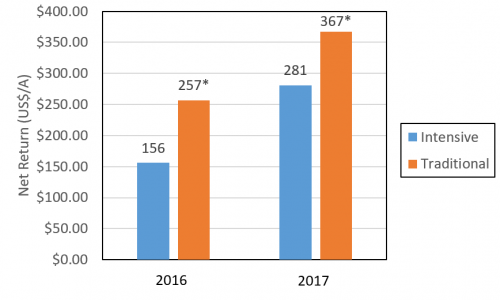Macros, micros and magical mixes in winter wheat
Is input-intensive management the key to increasing wheat grain yield and producer profitability?
Do simple better. A phrase we don’t often hear in production agriculture but perhaps deserves greater attention even as Michigan wheat growers continue to produce top national wheat yields. Locally, yield potential is often challenged by Michigan’s spring climatic variability, causing producers anxiety towards capitalizing on the high yield potential. High yield potential combined with climatic risks and commercial marketing has encouraged many wheat growers to apply more agronomic inputs for maximum yield. However, many of the inputs being applied contain limited information validating the proposed benefits.
To better understand winter wheat response to input-intensive management, a multi-year research study supported by the Michigan Wheat Program was established on soft red winter wheat, ‘Sunburst’, evaluating six agronomic inputs commonly used in wheat production: urease inhibitor, nitrification inhibitor, plant growth regulator, foliar zinc (Zn), manganese (Mn), boron (B), fungicide and increased rates of nitrogen (N) fertilizer.
Inputs were evaluated utilizing an omission treatment design. To better understand wheat response to the removal of individual inputs, grain yield differences were examined between wheat that received all six inputs (i.e., intensive) and compared to wheat that contained all but one of the inputs. Inputs were also evaluated utilizing the reverse approach by comparing grain yield differences between wheat that had no additional inputs other than a base rate of nitrogen fertilizer (i.e., traditional) and compared to wheat that contained each individual input applied one at a time. The base rate of nitrogen fertilizer was 90 pounds per acre while the high nitrogen component consisted of a 20 percent increase in total nitrogen rate (108 pounds per acre).
Yield increased 11 bushel per acre in 2016 when the fungicide, applied at flowering, was added to the traditional system. Significant foliar disease pressure was present only in 2016, suggesting fungicide benefit occurred strictly in the presence of disease. Urease inhibitor increased yield by 7.8 bushels per acre when added to the intensive system, yet decreased yield by 7.5 bushels per acre when added to the traditional system in 2017. A urease inhibitor works to prevent urea hydrolysis to avoid nitrogen loss from volatilization. However, when urea is non-hydrolyzed, the urea molecule is mobile in the soil and subject to leaching loss.
The 2017 growing season produced 2 inches of rainfall immediately following nitrogen fertilizer applications. Therefore, the inconsistent urease inhibitor response observed across management systems suggested the combination of a urease inhibitor with the intensive nitrogen rate (108 pounds nitrogen per acre) allowed urea movement within the rooting zone, but still supplied adequate nitrogen due to the greater overall application rate. In contrast, the combination of a urease inhibitor with the lower traditional nitrogen rate (90 pounds nitrogen per acre) may not have supplied adequate nitrogen to the wheat plant following significant rainfall.
Across site-years, grain yield was not significantly increased utilizing intensive management (Fig. 1). The intensive system had an average product and application cost of $126 per acre with an average break-even yield of 32 bushels per acre while the traditional system had an average cost of $44 per acre and an average break-even yield of 11 bushels per acre. Traditional management containing only a university recommended nitrogen rate increased economic net return an average of $94 per acre over intensive management (Fig. 2). No single input applied generated a positive return on investment in either year. Although fungicide and urease inhibitor applications resulted in significant grain yield increases in 2016 and 2017, respectively, corresponding net return was not increased.
Figure 1. Winter wheat grain yield comparison between intensive (all six inputs) and traditional (no additional inputs other than base nitrogen rate) management revealed no significant differences, Lansing, Michigan, 2016-2017.
Figure 2. Comparing economic net return between intensive (all six inputs) and traditional (no additional inputs other than base nitrogen rate) winter wheat management, Lansing, Michigan, 2016-2017.
At current wheat commodity prices, trial results expose the economic risks from applying multiple insurance applications of agronomic inputs without the proper environmental conditions to provide for a positive response. Growers should instead look to utilize university recommended integrated pest management (IPM) principles (e.g., variety selection, disease thresholds, crop scouting) and nutrient recommendation guidelines to justify input applications for yield and profitability. Growers often perceive yield loss as a greater risk than profit loss. However, current results suggest producers should consider greater emphasis on profitability rather than protecting yield loss when deciding to incorporate additional inputs.
Simplicity is often about gains, not losses. As growers prepare for another growing season, doing simple better may be more about gains made by removing distractions as compared to perceived yield losses by not applying what may be prophylactic inputs.
For additional information on this research trial and others, please visit the Michigan State University Soil Fertility Research website and view our online video updates.
Dr. Steinke’s work is funded in part by MSU’s AgBioResearch.



 Print
Print Email
Email

